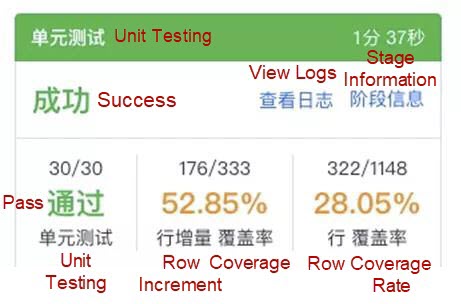Unit testing plays its value in all processes of software development as a powerful weapon of development. The process of the original development model should gradually change to the mode of DevOps. After the development, the software will be handed over to the test team for end-to-end tests. This article is an example of a specific practical process of transformation. This article introduces some common problems encountered in the process of expanding the unit testing practice using a real-world application project. This article also introduces several mock methods for reference in some businesses with more complex dependencies.

Testing is an effective means to ensure code quality, while unit testing is the minimum verification of program modules. The importance of unit testing is self-evident. Compared with manual testing, unit testing features automatic execution, automatic regression, and high efficiency. Unit testing also has relatively high problem discovery efficiency. You can write a unit testing case in the development phase, daily push daily test, and measure the quality of the code by the success rate and coverage rate of unit testing. This ensures the overall quality of the project.

What is good unit testing? The Alibaba Java Coding Guidelines describes the characteristics of good unit testing:
The unit testing should be repeatable, and external dependencies and environmental changes should be blocked by mock or other means.
The article "On the Architecture for Unit Testing" [1] provides the following descriptions of good unit testing:
Many people are not willing to write the unit testing because the project relies on a lot of calls between various functions and do not know how to test in an isolated test environment.
In practice, we investigated several mock methods. The following section describes these methods one by one.
The engineering project of this practice is an HTTP (gin-based HTTP framework) service. This article will introduce the unit testing process and take the function of the controller layer of the entrance as the measured function. The following function generates the CodeReview data of the code repository of the user based on the employee ID.
As we can see below, this function is relatively simple to use as the entry layer. It performs a parameter verification, calls the downstream, and reveals the result.
func ListRepoCrAggregateMetrics(c *gin.Context) {
workNo := c.Query("work_no")
if workNo == "" {
c.JSON(http.StatusOK, errors.BuildRsp(errors.ErrorWarpper(errors.ErrParamError.ErrorCode, "work no miss"), nil))
return
}
crCtx := code_review.NewCrCtx(c)
rsp, err := crCtx.ListRepoCrAggregateMetrics(workNo)
if err != nil {
c.JSON(http.StatusOK, errors.BuildRsp(errors.ErrorWarpper(errors.ErrDbQueryError.ErrorCode, err.Error()), rsp))
return
}
c.JSON(http.StatusOK, errors.BuildRsp(errors.ErrSuccess, rsp))
}The rough results are listed below:
{
"data": {
"total": 10,
"code_review": [
{
"repo": {
"project_id": 1,
"repo_url": "test"
},
"metrics": {
"code_review_rate": 0.0977918,
"thousand_comment_count": 0,
"self_submit_code_review_rate": 0,
"average_merge_cost": 30462.584,
"average_accept_cost": 30388.75
}
}
]
},
"errorCode": 0,
"errorMsg": "Success"
}This function test will cover the following scenarios:
workNo is empty, an error is returned.workNo is not empty, downstream calls are successful, and repos cr aggregates data.workNo is not empty, downstream calls fail, and an error message is returned.This method connects all dependent storage systems, such as sqlite and redis, to a local host through configuration files. This way, the downstream has not been mocked but continues to call.
var db *gorm.DB
func getMetricsRepo() *model.MetricsRepo {
repo := model.MetricsRepo{
ProjectID: 2,
RepoPath: "/",
FileCount: 5,
CodeLineCount: 76,
OwnerWorkNo: "999999",
}
return &repo
}
func getTeam() *model.Teams {
team := model.Teams{
WorkNo: "999999",
}
return &team
}
func init() {
db, err := gorm.Open("sqlite3", "test.db")
if err != nil {
os.Exit(-1)
}
db.Debug()
db.DropTableIfExists(model.MetricsRepo{})
db.DropTableIfExists(model.Teams{})
db.CreateTable(model.MetricsRepo{})
db.CreateTable(model.Teams{})
db.FirstOrCreate(getMetricsRepo())
db.FirstOrCreate(getTeam())
}
type RepoMetrics struct {
CodeReviewRate float32 `json:"code_review_rate"`
ThousandCommentCount uint `json:"thousand_comment_count"`
SelfSubmitCodeReviewRate float32 `json:"self_submit_code_review_rate"`
}
type RepoCodeReview struct {
Repo repo.Repo `json:"repo"`
RepoMetrics RepoMetrics `json:"metrics"`
}
type RepoCrMetricsRsp struct {
Total int `json:"total"`
RepoCodeReview []*RepoCodeReview `json:"code_review"`
}
func TestListRepoCrAggregateMetrics(t *testing.T) {
w := httptest.NewRecorder()
_, engine := gin.CreateTestContext(w)
engine.GET("/api/test/code_review/repo", ListRepoCrAggregateMetrics)
req, _ := http.NewRequest("GET", "/api/test/code_review/repo?work_no=999999", nil)
engine.ServeHTTP(w, req)
assert.Equal(t, w.Code, 200)
var v map[string]RepoCrMetricsRsp
json.Unmarshal(w.Body.Bytes(), &v)
assert.EqualValues(t, 1, v["data"].Total)
assert.EqualValues(t, 2, v["data"].RepoCodeReview[0].Repo.ProjectID)
assert.EqualValues(t, 0, v["data"].RepoCodeReview[0].RepoMetrics.CodeReviewRate)
}We have not changed the tested code above. However, we must specify the configuration to the test configuration when we run the Go test. The project to be tested is set through environment variables.
RDSC_CONF=$sourcepath/test/data/config.yml go test -v -cover=true -coverprofile=$sourcepath/cover/cover.cover ./...Gomock [2], provided by Golang, is a mock framework used in Go. It can be integrated with the Go testing module and used in other test environments. Gomock includes two parts, the gomock, and the mockgen. Gomock manages the pile objects, and mockgen generates the corresponding mock files.
type Foo interface {
Bar(x int) int
}
func SUT(f Foo) {
// ...
}
ctrl := gomock.NewController(t)
// Assert that Bar() is invoked.
defer ctrl.Finish()
//mockgen -source=foo.g
m := NewMockFoo(ctrl)
// Asserts that the first and only call to Bar() is passed 99.
// Anything else will fail.
m.
EXPECT().
Bar(gomock.Eq(99)).
Return(101)
SUT(m)In the example above, the Foo interface is mocked. Back to our project, in our test code above, it is called through an internal declaration object. When gomock is used, the code needs to be modified to expose dependencies through parameters, and then initialization is performed. The modified function that will be tested is listed below:
type RepoCrCRController struct {
c *gin.Context
crCtx code_review.CrCtxInterface
}
func NewRepoCrCRController(ctx *gin.Context, cr code_review.CrCtxInterface) *TeamCRController {
return &TeamCRController{c: ctx, crCtx: cr}
}
func (ctrl *RepoCrCRController)ListRepoCrAggregateMetrics(c *gin.Context) {
workNo := c.Query("work_no")
if workNo == "" {
c.JSON(http.StatusOK, errors.BuildRsp(errors.ErrorWarpper(errors.ErrParamError.ErrorCode, "Employee ID information error"), nil))
return
}
rsp, err := ctrl.crCtx.ListRepoCrAggregateMetrics(workNo)
if err != nil {
c.JSON(http.StatusOK, errors.BuildRsp(errors.ErrorWarpper(errors.ErrDbQueryError.ErrorCode, err.Error()), rsp))
return
}
c.JSON(http.StatusOK, errors.BuildRsp(errors.ErrSuccess, rsp))
}Now, we can test the mock interface generated by gomock:
func TestListRepoCrAggregateMetrics(t *testing.T) {
ctrl := gomock.NewController(t)
defer ctrl.Finish()
m := mock.NewMockCrCtxInterface(ctrl)
resp := &code_review.RepoCrMetricsRsp{
}
m.EXPECT().ListRepoCrAggregateMetrics("999999").Return(resp, nil)
w := httptest.NewRecorder()
ctx, engine := gin.CreateTestContext(w)
repoCtrl := NewRepoCrCRController(ctx, m)
engine.GET("/api/test/code_review/repo", repoCtrl.ListRepoCrAggregateMetrics)
req, _ := http.NewRequest("GET", "/api/test/code_review/repo?work_no=999999", nil)
engine.ServeHTTP(w, req)
assert.Equal(t, w.Code, 200)
got := gin.H{}
json.NewDecoder(w.Body).Decode(&got)
assert.EqualValues(t, got["errorCode"], 0)
}In the example above, we need to modify the code to implement the mock interface. For object member functions, mock is impossible. The monkey patch implements the mock of the instance method by modifying the contents of the underlying pointer at runtime. Note: The instance method must be accessible. The tests in the monkey mode are listed below:
func TestListRepoCrAggregateMetrics(t *testing.T) {
w := httptest.NewRecorder()
_, engine := gin.CreateTestContext(w)
engine.GET("/api/test/code_review/repo", ListRepoCrAggregateMetrics)
var crCtx *code_review.CrCtx
repoRet := code_review.RepoCrMetricsRsp{
}
monkey.PatchInstanceMethod(reflect.TypeOf(crCtx), "ListRepoCrAggregateMetrics",
func(ctx *code_review.CrCtx, workNo string) (*code_review.RepoCrMetricsRsp, error) {
if workNo == "999999" {
repoRet.Total = 0
repoRet.RepoCodeReview = []*code_review.RepoCodeReview{}
}
return &repoRet, nil
})
req, _ := http.NewRequest("GET", "/api/test/code_review/repo?work_no=999999", nil)
engine.ServeHTTP(w, req)
assert.Equal(t, w.Code, 200)
var v map[string]code_review.RepoCrMetricsRsp
json.Unmarshal(w.Body.Bytes(), &v)
assert.EqualValues(t, 0, v["data"].Total)
assert.Len(t, v["data"].RepoCodeReview, 0)
}Go-sqlmock can mock the interface sql/driver [3]. It removes the need for a real database and simulates the behavior of the sql driver to implement a powerful underlying data test. The following example shows how to use table driven [4] to perform data-related tests:
package store
import (
"database/sql/driver"
"github.com/DATA-DOG/go-sqlmock"
"github.com/gin-gonic/gin"
"github.com/jinzhu/gorm"
"github.com/stretchr/testify/assert"
"net/http/httptest"
"testing"
)
type RepoCommitAndCRCountMetric struct {
ProjectID uint `json:"project_id"`
RepoCommitCount uint `json:"repo_commit_count"`
RepoCodeReviewCommitCount uint `json:"repo_code_review_commit_count"`
}
var (
w = httptest.NewRecorder()
ctx, _ = gin.CreateTestContext(w)
ret = []RepoCommitAndCRCountMetric{}
)
func TestCrStore_FindColumnValues1(t *testing.T) {
type fields struct {
g *gin.Context
db func() *gorm.DB
}
type args struct {
table string
column string
whereAndOr []SqlFilter
group string
out interface{}
}
tests := []struct {
name string
fields fields
args args
wantErr bool
checkFunc func()
}{
{
name: "whereAndOr is null",
fields: fields{
db: func() *gorm.DB {
sqlDb, mock, _ := sqlmock.New(sqlmock.QueryMatcherOption(sqlmock.QueryMatcherEqual))
rs1 := sqlmock.NewRows([]string{"project_id", "repo_commit_count", "repo_code_review_commit_count"}).FromCSVString("1, 2, 3")
mock.ExpectQuery("SELECT project_id, sum(commit_count) as repo_commit_count, sum(code_review_commit_count) as repo_code_review_commit_count FROM `metrics_repo_cr` GROUP BY project_id").WillReturnRows(rs1)
gdb, _ := gorm.Open("mysql", sqlDb)
gdb.Debug()
return gdb
},
},
args: args{
table: "metrics_repo_cr",
column: "project_id, sum(commit_count) as repo_commit_count, sum(code_review_commit_count) as repo_code_review_commit_count",
whereAndOr: []SqlFilter{},
group: "project_id",
out: &ret,
},
checkFunc: func() {
assert.EqualValues(t, 1, ret[0].ProjectID, "project id should be 1")
assert.EqualValues(t, 2, ret[0].RepoCommitCount, "RepoCommitCount id should be 2")
assert.EqualValues(t, 3, ret[0].RepoCodeReviewCommitCount, "RepoCodeReviewCommitCount should be 3")
},
},
{
name: "whereAndOr is not null",
fields: fields{
db: func() *gorm.DB {
sqlDb, mock, _ := sqlmock.New(sqlmock.QueryMatcherOption(sqlmock.QueryMatcherEqual))
rs1 := sqlmock.NewRows([]string{"project_id", "repo_commit_count", "repo_code_review_commit_count"}).FromCSVString("1, 2, 3")
mock.ExpectQuery("SELECT project_id, sum(commit_count) as repo_commit_count, sum(code_review_commit_count) as repo_code_review_commit_count FROM `metrics_repo_cr` WHERE (metrics_repo_cr.project_id in (?)) GROUP BY project_id").
WithArgs(driver.Value(1)).WillReturnRows(rs1)
gdb, _ := gorm.Open("mysql", sqlDb)
gdb.Debug()
return gdb
},
},
args: args{
table: "metrics_repo_cr",
column: "project_id, sum(commit_count) as repo_commit_count, sum(code_review_commit_count) as repo_code_review_commit_count",
whereAndOr: []SqlFilter{
{
Condition: SQLWHERE,
Query: "metrics_repo_cr.project_id in (?)",
Arg: []uint{1},
},
},
group: "project_id",
out: &ret,
},
checkFunc: func() {
assert.EqualValues(t, 1, ret[0].ProjectID, "project id should be 1")
assert.EqualValues(t, 2, ret[0].RepoCommitCount, "RepoCommitCount id should be 2")
assert.EqualValues(t, 3, ret[0].RepoCodeReviewCommitCount, "RepoCodeReviewCommitCount should be 3")
},
},
{
name: "group is null",
fields: fields{
db: func() *gorm.DB {
sqlDb, mock, _ := sqlmock.New(sqlmock.QueryMatcherOption(sqlmock.QueryMatcherEqual))
rs1 := sqlmock.NewRows([]string{"project_id", "repo_commit_count", "repo_code_review_commit_count"}).FromCSVString("1, 2, 3")
mock.ExpectQuery("SELECT project_id, sum(commit_count) as repo_commit_count, sum(code_review_commit_count) as repo_code_review_commit_count FROM `metrics_repo_cr` WHERE (metrics_repo_cr.project_id in (?))").
WithArgs(driver.Value(1)).WillReturnRows(rs1)
gdb, _ := gorm.Open("mysql", sqlDb)
gdb.Debug()
return gdb
},
},
args: args{
table: "metrics_repo_cr",
column: "project_id, sum(commit_count) as repo_commit_count, sum(code_review_commit_count) as repo_code_review_commit_count",
whereAndOr: []SqlFilter{
{
Condition: SQLWHERE,
Query: "metrics_repo_cr.project_id in (?)",
Arg: []uint{1},
},
},
group: "",
out: &ret,
},
checkFunc: func() {
assert.EqualValues(t, 1, ret[0].ProjectID, "project id should be 1")
assert.EqualValues(t, 2, ret[0].RepoCommitCount, "RepoCommitCount id should be 2")
assert.EqualValues(t, 3, ret[0].RepoCodeReviewCommitCount, "RepoCodeReviewCommitCount should be 3")
},
},
}
for _, tt := range tests {
t.Run(tt.name, func(t *testing.T) {
cs := &CrStore{
g: ctx,
}
db = tt.fields.db()
if err := cs.FindColumnValues(tt.args.table, tt.args.column, tt.args.whereAndOr, tt.args.group, tt.args.out); (err != nil) != tt.wantErr {
t.Errorf("FindColumnValues() error = %v, wantErr %v", err, tt.wantErr)
}
tt.checkFunc()
})
}
}Aone, the Alibaba internal project collaboration management platform, provides a function similar to travis-ci [5]: the test service [6]. We can perform unit testing integration by creating a unit testing task or using the lab.
# Run the test command.
mkdir -p $sourcepath/cover
RDSC_CONF=$sourcepath/config/config.yaml go test -v -cover=true -coverprofile=$sourcepath/cover/cover.cover ./...
ret=$?; if [[ $ret -ne 0 && $ret -ne 1 ]]; then exit $ret; fiIncremental coverage can be converted to xml reports through gocov/gocov-xml incremental report output through diff_cover:
cp $sourcepath/cover/cover.cover /root/cover/cover.cover
pip install diff-cover==2.6.1
gocov convert cover/cover.cover | gocov-xml > coverage.xml
cd $sourcepath
diff-cover $sourcepath/coverage.xml --compare-branch=remotes/origin/develop > diff.outThen, set the triggered integration phase:

[1] https://thomasvilhena.com/2020/04/on-the-architecture-for-unit-testing
[2] https://github.com/golang/mock
[3] https://godoc.org/database/SQL/driver
Alibaba System Software - August 14, 2018
Alibaba Developer - August 27, 2018
Alibaba Clouder - April 19, 2021
Alibaba Cloud Native Community - March 14, 2023
VikashThakur - December 24, 2024
Alex - January 22, 2020
 Mobile Testing
Mobile Testing
Provides comprehensive quality assurance for the release of your apps.
Learn More DevOps Solution
DevOps Solution
Accelerate software development and delivery by integrating DevOps with the cloud
Learn More Alibaba Cloud Flow
Alibaba Cloud Flow
An enterprise-level continuous delivery tool.
Learn More Storage Capacity Unit
Storage Capacity Unit
Plan and optimize your storage budget with flexible storage services
Learn More